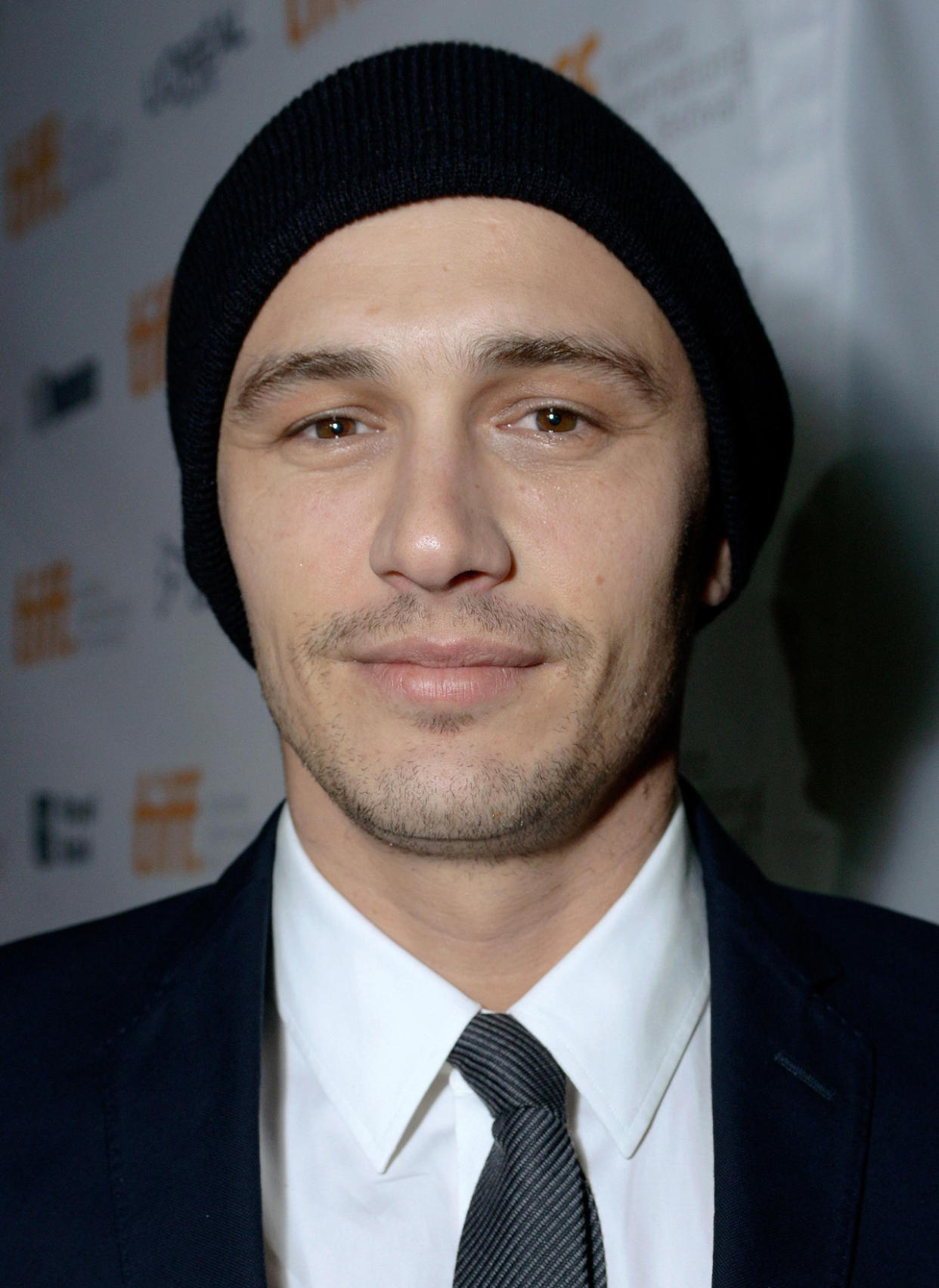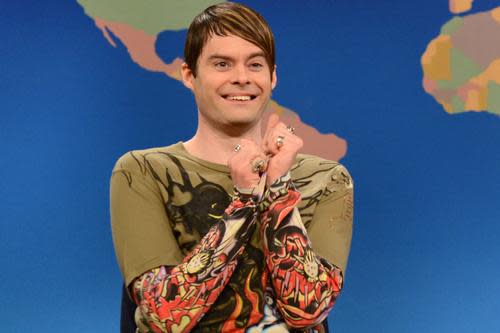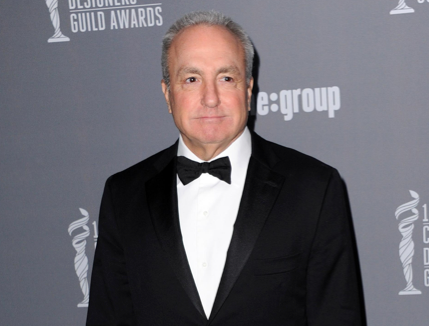James Franco Talks About Challenges of Making His 'SNL' Documentary 'Saturday Night'

With Saturday Night Live approaching its 40th season, the show’s behind-the-scenes culture has become the stuff of legend. SNL’s sleepless comedy-writing marathons and weird power dynamics have been written about, documented, and fictionalized so often that it feels like fans have seen it all before.
Yet James Franco managed to find a new way in for his feature-length documentary Saturday Night (now available on Hulu Plus). In the film — which was, in fact, completed in 2010 — Franco documents the weeklong process of creating an episode of SNL, specifically the December 2008 show starring John Malkovich. What distinguishes Saturday Night from previous documentaries is Franco’s level of access: the two-time host attends a pitch meeting in producer Lorne Michaels’s office, stays up all night with the writers, and is there when NBC’s department of Standards and Practices demands that the fake Italian word “fagula” be axed.
There’s plenty of inherent drama in the creation of the show: Every moment is an audition for the actors and writers, and no one knows for sure what the episode will look like until it happens. In an exclusive interview with Yahoo, director James Franco talks about the process of making Saturday Night, and what he thinks it gets right — and wrong — about the goings-on at 30 Rock.

So how did you get permission to make this movie?
Well — it all started when I was at NYU, I was a graduate film student. I’d gone back to school, so I already had a film career going, and I had recently hosted SNL. And I had such a good experience that when I was given my second assignment ever assignment at NYU — to make a seven-minute observational documentary about someone. I thought, ‘Oh, wouldn’t it be cool if I followed Bill Hader (above) for a week of his life on SNL?’ And Bill was game. And then I realized, even though Bill has given me permission, I’m probably gonna have to get, you know, permission from [SNL creator and executive producer] Lorne Michaels. Turns out Lorne was fine, but then he said, “Well, you’re gonna have to get the permission of the host.” [Laughs] So I was like, “Oh, John Malkovich? OK…” I’d never met John Malkovich. And he was the coolest. He was like [in his best John Malkovich voice]: “No problem, no problem, James.” And so, once [all the] permission, I realized: Why am I wasting this on a seven-minute student assignment? I have just been granted access that no one else has been given.
In general, coverage of SNL is very reverent, because it’s a legendary institution. But in the first 10 minutes of Saturday Night, you’re talking to Will Forte, and saying “The pitch meeting is kind of bullshit, right?”
[Laughs] Yeah. I’m a huge fan of SNL, and I’d watched a lot of the previous documentaries about it. And they usually take a historical look at the show, and the format is a lot of B-roll, combined with talking-head interviews, where people are talking about what it was like. But rarely do you really get to see much of the actual process. And so I thought, if we get that, if we get to do that, then we’ll have something that’s: (a) new, and also, (b) I think really valuable, for anybody who’s interested in comedy, or writing, or who is interested in the way certain kinds of television work.

Lorne Michaels 15th Annual Costume Designers Guild Awards in Beverly Hills, Feb. 19, 2013
Did Lorne have any parameters or limits for you? Did he get final cut?
Here’s the thing: Lorne (above) is so cool. And I’m sure you can hear from everybody who’s been on the show, that he’s sort of this strange, slightly mysterious father figure. But the thing that Lorne knows how to do, is work with creative people. And treat them in such a way that their creativity can thrive. And so, once he gave us permission, he was cool! He didn’t say anything to us! In fact, I asked for what people had told me was the un-askable — which is go into his officewhen he was making selections about which sketches would go on. If nobody has filmed a Tuesday-night writing spree, certainly no one has ever, ever filmed Lorne in his office, making those kinds of decisions. So I guess it just shows how supportive he was of the documentary. Now, that being said — yeah, we were always gonna run it by him. [Laughs] And in fact, because the documentary was made before we even knew what it was going to be, we didn’t have certain kinds of permission and signatures that you would normally have beforehand. But in the end it, really, it was fine. Everybody approved, everybody signed off.
At one point, there’s a conversation between you and Lorne, in which he says you’re not going to get a totally authentic behind-the-scenes picture of SNL because you’re bringing a camera into a building full of performers. What’s your take on that? First of all, obviously, I shot it and edited it; my editor, Ian Olds, could have easily taken that scene out, right? We didn’t have to have Lorne questioning the objectivity of our documentary, but we put it in there because we thought it was important to have a little bit of pushback — that it would be interesting to put a question mark within the movie itself. That being said, having been on the show two times as a host, and multiple times just as a little guest here and there, and having known many, many people who have worked on the show, and being friends with a lot of them — I think we got a pretty good portrait of what it’s like! [Laughs] I think Lorne’s comment is true, that yes, when you put a camera in a room, people change. But we’re also dealing in this documentary with people that are used to being in front of a camera. Fifty sketches were submitted for this show, and nine got on the air. As a writer yourself, was it tough for you to watch the writers work all night on these sketches, only to see most of them get cut? It’s not like that was a surprise to me; I’ve been on the show before, so I knew what it was like. I guess, in a funny way, our documentary pays tribute to all the work they did that ended up on the cutting-room floor. So in fact, we’re actually documenting all that work. Otherwise, people would have no idea about it. And the other thing I’ll say about that section, is that it was only difficult because in our documentary, we only cover one week. And so it gives us a really false impression of who’s up and who’s down, you know what I mean? All the cast members and all the writers said to me, “Look, we all have our bad weeks, we all have our weeks where we’re bombing in there.” The sketches that didn’t get selected on the particular episode that I covered, were just the ones that particular week. One sketch that was cut in dress featured John Malkovich singing the Empire Carpets jingle. So thanks to you, I now get to hear that in John Malkovich’s voice whenever it comes on. [Laughs] I do that too! In the cab, I’m like, “Oh yeah, John Malkovich sang that.” Photo credit: WireImage, Associated Press

